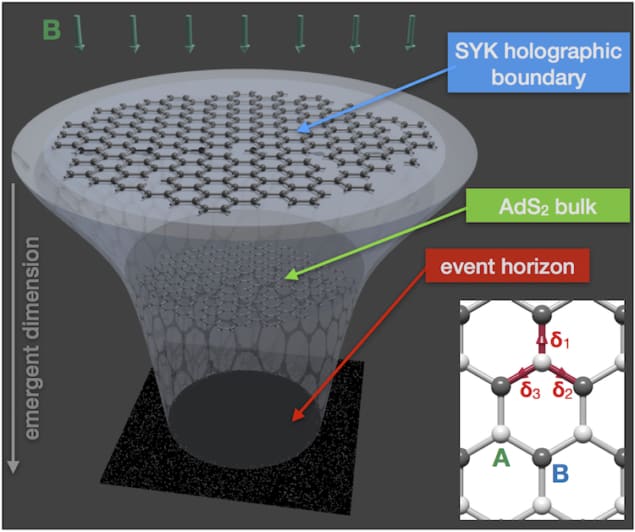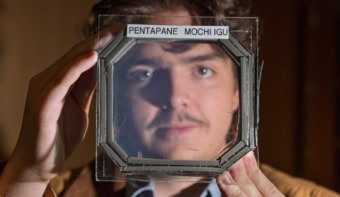
Much research on black holes is theoretical since it is difficult to make actual measurements on real black holes. Such experiments also need to be undertaken over decades or longer. Physicists are therefore keen to create laboratory systems that are analogous to these cosmic entities. New theoretical calculations by a team in Canada, the US, UK and Israel have now revealed that a material as simple as a graphene flake with an irregular boundary subjected to an intense external magnetic field can be used to create a quantum hologram that faithfully reproduces some of the signature characteristics of a black hole. This is because the electrons in the carbon material behave according to the Sachdev-Ye-Kitaev model.
Some of the most important unresolved mysteries in modern physics come from the “incompatibility” between Einstein’s theory of general relativity and the theory of quantum mechanics. General relativity describes the physics of the very big (the force of gravity and all that it affects: spacetime, planets, galaxies and the expansion of the Universe). The theory of quantum mechanics is the physics of the very small – and the other three forces, electromagnetism and the two nuclear forces.
“In recent years, physicists have gleaned important new insights into these questions through the study of the SYK model,” explains Marcel Franz of the University of British Columbia in Canada, who led this research effort. “This model is an illustration of a type of ‘holographic duality’ in which a lower-dimensional system can be represented by a higher dimensional one. In our calculations, the former is N graphene electrons in (0+1) dimensions and the latter the dilation gravity of a black hole in (1+1) dimensional anti-de Sitter (AdS2) space.”
Remarkably, this model accurately describes the physical characteristics of black holes for large values of N (larger than 100 ideally). These characteristics include non-zero residual entropy, and fast scrambling of quantum information at the black hole singularity (the region beyond which not even light can escape the tug of its gravity).
Irregular boundary
Franz and colleagues’ simple experimental realization of the SYK model involves electrons in a graphene flake (a sheet of carbon just one atom thick) that has an irregular boundary. It must be irregular in order to imprint randomness onto the electrons, Franz tells Physics World. “We need this because random structure of electron-electron interactions is the essential requirement of the SYK model.
“Unlike earlier solid-state system proposals to demonstrate this model, our device does not require advanced fabrication techniques and should therefore be relatively straightforward to assemble using existing technologies.”
When a magnetic field B is applied to graphene a number of interesting quantum phases are produced. At a simple (“non-interacting”) level, the field simply reorganizes the single-particle electron states in the material into Dirac Landau levels with certain energies. When the graphene flake is sufficiently small (ideally around 100-200 nm in size), the electrons in the n=0 Landau level are described by the SYK model thanks to the so-called Aharonov-Casher construction.
The team, which includes researchers from Tel-Aviv University in Israel, the Rudolf Peierls Centre for Theoretical Physics in Oxford in the UK, and Microsoft Research in Santa Barbara in the US, says that it is now busy trying to better understand the behaviour of graphene electrons in the SYK regime. “We hope that our theory results will motivate experimentalists to study graphene flakes of the type required to produce SYK physics,” says Franz.
The black hole hologram is described in Physical Review Letters 10.1103/PhysRevLett.121.036403.



